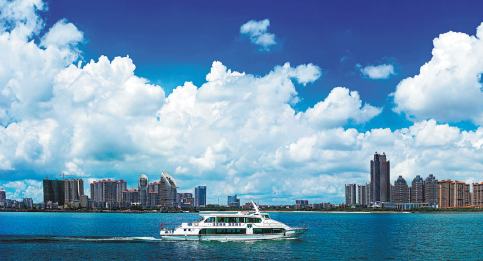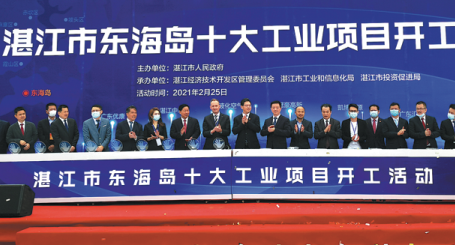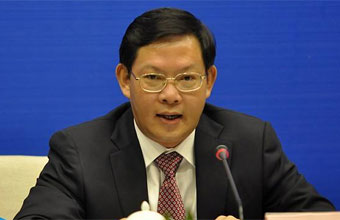Home> News
Cruising ahead to provincial subcenter
Zhanjiang host to major port-based projects that helped expand economy and high-quality growth
Zhanjiang, a port city in South China's Guangdong province, enjoyed sustained growth during the 13th Five-Year Plan (2016-20), with remarkable progress made in industrial development and transport.
In 2019, Zhanjiang moved into top gear to build itself into a subcenter of the province as well as a major area of growth in the country's modern coastal economic belt.
Authorities are committed to deepening supply-side structural reform, cultivating a host of modern industries and optimizing economic structure, Zhanjiang Mayor Zeng Jinze said in his government work report earlier this year.

Zhanjiang in Guangdong province is cultivating a host of modern industries and optimizing its economic structure. FANG XIONG/FOR CHINA DAILY
Zhanjiang's GDP stood at 310 billion yuan ($47.88 billion) last year, with average annual growth of 5.1 percent over the past five years. The added value of industries above designated size-those with annual revenue of 20 million yuan or more-grew by 5.4 percent year-on-year to nearly 64 billion yuan.
According to the report, port-based industries thrived. Four key projects, each with an investment of more than $10 billion, are proceeding smoothly.
Among them, the Zhongke (Guangdong) Refinery and Petrochemical project, which began operation in June 2020, is able to achieve an annual output value of 60 billion yuan. The project will also generate profits and taxes amounting to 26 billion yuan annually.
In addition, the smart Verbund petrochemical project from German chemicals giant BASF is China's first large petrochemical project owned solely by foreign investors. Its first phrase is estimated to be completed by the end of this year.
The projects paved the way for Zhanjiang to become South China's port-based industry center and pushed forward the city's high-quality development, Zeng said.
As the city government implemented the innovation-driven strategies, a host of high-tech companies chose Zhanjiang as their home.
By the end of last year, Zhanjiang was host to 301 high-tech enterprises, up sevenfold since 2016.
A group of innovation institutions were also put into operation, including the Southern Marine Science and Engineering Guangdong Laboratory and the Zhanjiang Marine High-tech Industry Innovation Center.
Zeng said the city is accelerating the construction of 5G base stations and aims to launch a big data industrial park this year.
Zhanjiang attached great importance to the construction of transport infrastructure in a bid to become a national comprehensive transport hub.

A groundbreaking ceremony takes place for 10 major industrial projects in Zhanjiang in late February. QI ZHAO/FOR CHINA DAILY
Statistics show the combined investment in transport infrastructure in the city reached 70 billion yuan over the past five years, 2.6 times the figure of the 12th Five-Year Plan (2011-15).
Xuwen Port's new roll-on roll-off cargo-passenger dock, which came into service in September 2020, is the world's largest of its kind. It halved the shipping time to Xinhai Port in Haikou, Hainan province, to around one hour.
The Zhanjiang International Airport relocation and expansion project started in October 2019 and is expected to be completed this year.
With an investment of about 4.9 billion yuan, the project includes a 61,800-square-meter terminal, a 3,200-meter runway, and 30 aircraft stands. Upon completion, it will become the third-largest airport in the province, behind those in Guangzhou and Shenzhen.
Construction of many other transport infrastructure projects in the city is in full swing.
After expansion, Zhanjiang Port will be the only deep-water port in South China qualified to handle 400,000-tonnage vessels.
In addition, the Guangzhou-Zhanjiang high-speed railway with a designed speed of 350 kilometers per hour is to open in 2024.
In the long run, Zhanjiang plans to build an extensive railway network consisting of five high-speed rail lines. They are to link Guangzhou and Shenzhen in Guangdong province, Haikou in Hainan province, Zhangjiajie in Hunan province and Hepu in the Guangxi Zhuang autonomous region. This will help Zhanjiang participate in the two-hour traffic circle in the Pearl River Delta region and strengthen interconnectivity with the southwestern region, according to the city government.

 Print
Print Mail
Mail 5G construction supports Zhanjiang's high-quality development
5G construction supports Zhanjiang's high-quality development
 Acting mayor inspects project construction in Xuwen, Leizhou
Acting mayor inspects project construction in Xuwen, Leizhou Zhanjiang island an "egret paradise"
Zhanjiang island an "egret paradise"  Dancing egrets add vitality to Xiashan
Dancing egrets add vitality to Xiashan